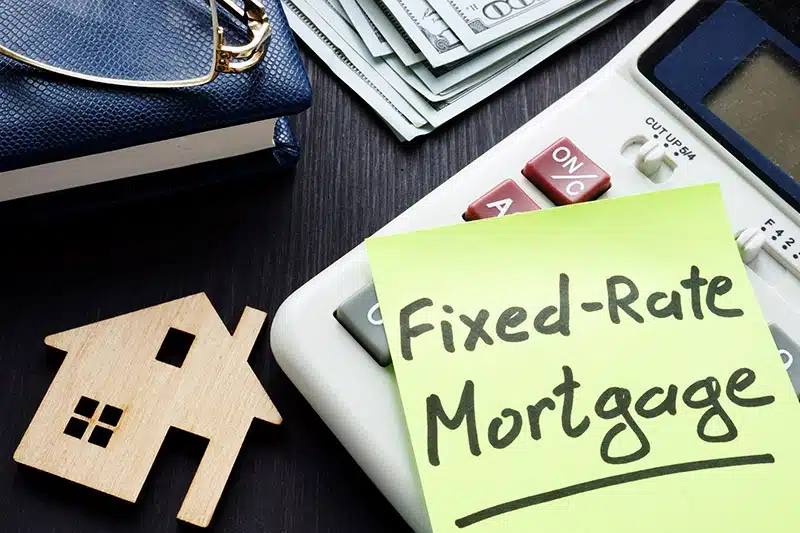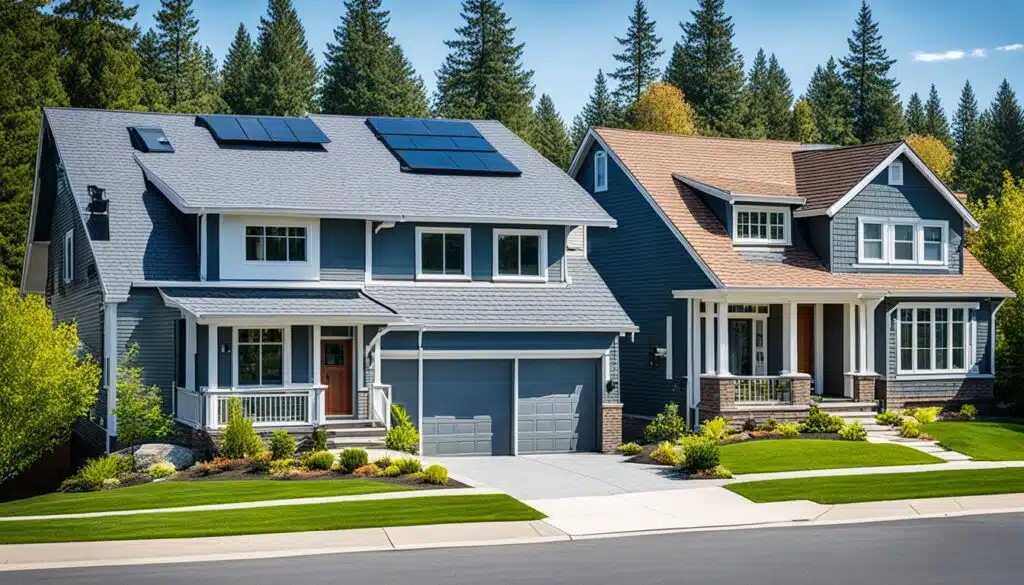Choosing the right mortgage can feel overwhelming, especially when looking at fixed-rate loans versus adjustable-rate mortgages (ARM). Each option has its pros and cons. Your financial goals, how much risk you can handle, and your future plans matter a lot. We’ll look at what to think about when deciding if a fixed-rate loan fits your mortgage needs.
Key Takeaways
- Understanding the difference between fixed-rate loans and adjustable-rate mortgages (ARMs) is crucial when choosing a mortgage.
- Fixed-rate loans offer predictable monthly payments and protection from rising interest rates, but they may have higher interest rates than ARMs.
- ARMs provide more flexibility and the potential for lower initial interest rates, but they also carry the risk of future rate increases.
- Factors like your financial goals, risk tolerance, and projected stay in the home should all be considered when deciding between a fixed-rate loan and an ARM.
- Consulting with a mortgage professional can help you make an informed decision that aligns with your unique circumstances and long-term financial needs.
Understanding Fixed-Rate Mortgages
A fixed-rate mortgage is a loan with a constant interest rate for its entire term, usually 15 or 30 years. This loan type offers borrowers predictable monthly payments. The payment mix of principal and interest doesn’t change over the loan’s life.
The amortization schedule for these mortgages shows how the payment allocation changes over time. More goes towards the principal as the loan ends.
What is a Fixed-Rate Mortgage?
A fixed-rate mortgage is a home loan with a constant interest rate throughout the loan. This means monthly payments for principal and interest stay the same. It helps borrowers plan their finances better.
How Fixed-Rate Mortgages Work
At loan start, the interest rate is set and stays the same for the loan’s 15 or 30 years. Monthly payments are based on the loan amount, interest rate, and repayment period. This results in consistent and predictable payments.
| Loan Amount | Interest Rate | Loan Term | Monthly Payment |
|---|---|---|---|
| $300,000 | 4.5% | 30 years | $1,520 |
| $200,000 | 5.0% | 15 years | $1,509 |
Advantages of Fixed-Rate Mortgages

Choosing between a fixed-rate loan and an adjustable-rate mortgage (ARM) is crucial for your finances. A fixed-rate mortgage is great because it makes your monthly payments predictable. Unlike ARMs, which can change with interest rates, a fixed-rate mortgage keeps your payments the same for the loan’s life.
Predictable Monthly Payments
With a fixed-rate mortgage, you can budget easily, knowing your monthly payment won’t change. This is great for those who like financial stability and don’t want to worry about changing rates. It helps you manage your money better and reach your financial goals.
Protection from Rising Interest Rates
A fixed-rate mortgage also protects you from rising interest rates. ARMs might start low but can go up if rates get higher. A fixed-rate loan keeps your payments steady, giving you interest rate protection. This can make you feel more secure about your finances.
“The predictability of a fixed-rate mortgage can be a game-changer for many homeowners, allowing them to budget and plan with confidence.”
Disadvantages of Fixed-Rate Mortgages
Fixed-rate mortgages provide stability and predictability. However, they also have some drawbacks. The main downsides include higher interest rates and the inability to immediately benefit from a rate reduction.
Higher Interest Rates
Lenders charge more for the certainty of a fixed interest rate over the loan’s life. This means fixed-rate mortgages often have higher interest rates than adjustable-rate mortgages (ARMs) at first. The trade-off for stability is paying a bit more upfront.
No Immediate Rate Reduction
A fixed-rate mortgage means your payments won’t go down if interest rates drop. You’d need to refinance to get a lower interest rate. Refinancing comes with costs and fees that might cancel out the savings. Borrowers with fixed-rate mortgages must wait for their loan to end or refinance to enjoy lower interest rates.
| Fixed-Rate Mortgage Disadvantages | Description |
|---|---|
| Higher Interest Rates | Lenders charge a premium for the certainty of a fixed interest rate, resulting in higher rates compared to adjustable-rate mortgages (ARMs). |
| No Immediate Rate Reduction | Borrowers with fixed-rate mortgages cannot immediately benefit from declining interest rates unless they refinance, which incurs additional costs. |
The main issues with fixed-rate mortgages are the higher upfront costs and not being able to use lower interest rates without refinancing. These points should be thought over when deciding between a fixed-rate or adjustable-rate mortgage.
Adjustable-Rate Mortgages (ARMs)
.jpg)
Fixed-rate mortgages are stable and predictable fixed rate mortgage loan. Adjustable-rate mortgages (ARMs) offer a different choice for buyers. ARMs have interest rates that change over time with the market. This means monthly payments can change, but they often start lower than fixed-rate loans.
People thinking about an ARM loan should know its main points and risks:
- Adjustable Interest Rates: The interest rate on an ARM can go up or down at set times, like every year or five years, based on a financial index.
- Introductory “Teaser” Rates: ARMs start with a lower “teaser” rate, making them seem better than fixed-rate loans. But, the rate can go up, making payments higher.
- Payment Caps: ARMs have limits on how much the interest rate and payments can increase. This helps protect borrowers.
ARMs can save money, but their changing rates mean buyers must think about their future finances and market risks. Choosing an adjustable-rate mortgage over a fixed-rate loan is a big decision.
| Fixed-Rate Mortgage | Adjustable-Rate Mortgage (ARM) |
|---|---|
| Consistent, predictable monthly payments | Payments can change as interest rates do |
| Interest rate stays the same for the loan’s life | Interest rate changes based on the market |
| Long-term stability and protection from rising rates | Lower initial rate, but risk of higher payments later |
“Adjustable-rate mortgages can be a good option for homebuyers who plan to sell or refinance their home before the interest rate adjusts, or for those who are comfortable with the potential for higher monthly payments in the future.”
Fixed Rate Loan: Types and Terms
Fixed-rate mortgages offer various options for borrowers. They fall into two main categories: conventional and government-backed fixed-rate loans.
Conventional Fixed-Rate Mortgages
Conventional fixed-rate mortgages come from private lenders like banks and mortgage companies. They usually require a good credit score and steady 30-year fixed and fixed-rate mortgage loan. But, they offer competitive rates and flexible terms, making them popular among homebuyers.
Government-Backed Fixed-Rate Mortgages
Government-backed loans, such as FHA, VA, and USDA, are insured by federal agencies. They have easier rules for getting approved. This makes them a good choice for first-time buyers, those with lower credit scores, or small down payments.
| Loan Type | Eligibility Criteria | Interest Rates |
|---|---|---|
| Conventional Fixed-Rate Mortgage | Stricter credit and income requirements | Competitive, based on market conditions |
| FHA Fixed-Rate Mortgage | More flexible, lower down payment options | Slightly higher than conventional loans |
| VA Fixed-Rate Mortgage | Available to eligible military members and veterans | Typically lower than conventional loans |
| USDA Fixed-Rate Mortgage | Designed for low-income borrowers in rural areas | Competitive, with potential for subsidies |
Choosing a fixed-rate loan means looking at your finances, credit, and goals. This will help you pick the best option for you.
Fixed-Rate Mortgages vs. Adjustable-Rate Mortgages

Homebuyers often have to decide between fixed-rate and adjustable-rate mortgages. Knowing the main differences between these can help them choose the right variable rate one for their financial goals rate may and how much risk they can handle.
Interest Rate Differences
Fixed-rate mortgages have the same interest rate for the whole loan term. This means borrowers know exactly how much their monthly payments will be. ARMs, on the other hand, have an initial rate that can change over time. This means borrowers might see their monthly payments go up or down based on the market.
Risk Factors
- Fixed-rate mortgages are generally safer for borrowers because their payments don’t change with the market.
- ARMs can be riskier because payments can go up a lot if interest rates do mortgage rate. This could lead to financial trouble or even foreclosure.
| Mortgage Type | Interest Rate | Risk Factor |
|---|---|---|
| Fixed-Rate Mortgage | Consistent throughout the loan term | Lower risk for borrowers |
| Adjustable-Rate Mortgage (ARM) | Fluctuates based on market conditions | Higher risk for borrowers |
Understanding the differences between fixed-rate and adjustable-rate mortgages helps borrowers make a choice that fits their financial situation and how much risk they can take.
Also Read : Key Criteria Explained : Are You Eligible For A Loan Subsidy?
Conclusion
Choosing the right mortgage is key to your financial future. You need to think about your financial situation, how much risk you can handle, and your long-term goals. Fixed-rate mortgages give you stability and protect you from rising interest rates. They make your monthly payments predictable, which helps with budgeting.
ARMs, on the other hand, might have lower initial payments. But, you could face higher payments later if interest rates go up. The choice between these two depends on what you need.
If you want stability and predictable payments, a fixed-rate loan might be right for you. But, if you’re okay with some risk for possibly lower payments, consider an ARM payment amount. Think about your budget, future plans, and how much risk you can handle to pick the best mortgage for you.
It’s important to research and understand any mortgage product before you decide. By looking at the pros and cons of fixed-rate loans and ARMs, you can make a choice that helps you financially in the long run.
FAQs
Q: What is a fixed-rate loan?
A: A fixed-rate loan is a type of mortgage loan where the interest rate remains the same throughout the entire term of the loan, providing predictable monthly mortgage payments.
Q: What are the benefits of a fixed-rate mortgage?
A: The benefits of a fixed-rate mortgage include stability in your monthly payments, protection against rising interest rates, and easier budgeting over the life of the loan.
Q: How does a mortgage calculator help in choosing a fixed-rate loan?
A: A mortgage calculator helps you estimate your monthly mortgage payment, including principal and interest payments, allowing you to compare different loan options and understand the total cost of the loan.
Q: What is the difference between a 30-year fixed-rate and a 15-year fixed-rate mortgage?
A: A 30-year fixed-rate mortgage has a longer loan term resulting in lower monthly payments but more interest paid over time, while a 15-year fixed-rate mortgage has higher monthly payments but allows for faster equity building and less total interest paid.
Q: Are there any cons to a fixed-rate mortgage?
A: Yes, the cons of a fixed-rate mortgage include potentially higher initial interest rates compared to adjustable rate mortgages, and inflexibility if interest rates drop, as your rate remains locked for the entire term of the loan.
Q: What happens if interest rates rise after I choose a fixed-rate mortgage?
A: If interest rates rise after you choose a fixed-rate mortgage, your rate remains locked, which means you are shielded from increased rates, providing stability in your payments.
Q: Can I refinance a fixed-rate mortgage to take advantage of lower rates?
A: Yes, you can refinance a fixed-rate mortgage to take advantage of lower rates, which may reduce your monthly mortgage payment and overall interest payments over the life of the loan.
Q: What types of loans can be classified as fixed-rate mortgages?
A: Types of fixed-rate mortgages include 30-year fixed-rate, 15-year fixed-rate, and jumbo loans, each varying in terms of loan amount and duration.
Q: How does the annual percentage rate (APR) affect my fixed-rate mortgage?
A: The annual percentage rate (APR) includes the interest rate plus any associated fees, providing a more comprehensive view of the total cost of the loan, which is important when comparing fixed-rate mortgage options.
Q: Are VA loans available as fixed-rate mortgages?
A: Yes, VA loans can be offered as fixed-rate mortgages, providing veterans and eligible service members with the advantage of stable monthly payments and competitive interest rates.





